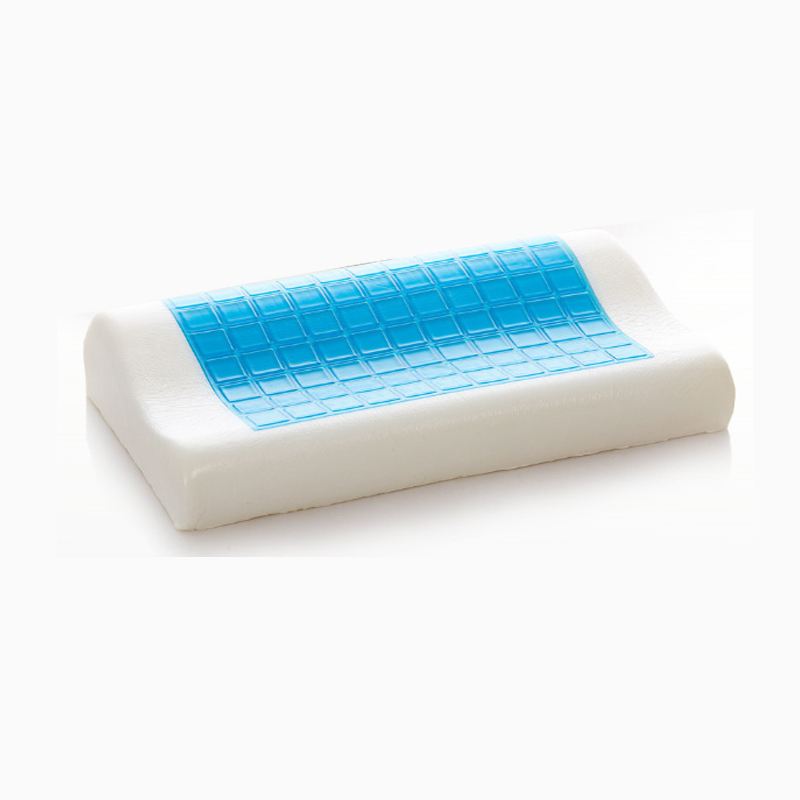Designing Cooling Gel Memory Foam Pillows to improve their thermal management capabilities requires consideration of material selection, structural design, manufacturing process, and user experience. The following are some key design strategies and technical methods:
1. Material optimization
(1) Selection of gel layer materials
Phase change material (PCM):
Phase change material changes its physical state (such as from solid to liquid) when absorbing or releasing heat, thereby effectively regulating temperature.
Advantages: It can maintain a constant temperature effect within a specific temperature range, which is suitable for nighttime sleeping environment.
Application: Embed PCM microcapsules into memory foam to form a uniformly distributed gel layer.
Liquid gel:
Liquid gel has high thermal conductivity and can quickly disperse the heat generated by the head.
Advantages: It cools down quickly and is suitable for hot environments.
Note: It is necessary to ensure that the liquid gel is firmly encapsulated to avoid leakage.
(2) Improvement of memory foam substrate
Open cell structure:
Use open cell memory foam with stronger breathability to promote air circulation and reduce heat accumulation.
Method: Adjust the porosity of memory foam through the foaming process to make it lighter and more breathable.
Thermal conductive additives: Add graphene, carbon fiber or other thermal conductive materials to memory foam to improve the overall thermal conductivity.
Advantages: Enhance the thermal conductivity while maintaining the softness and support of memory foam.
2. Structural design
(1) Gel layer layout optimization
Partition design: Concentrate the gel layer in the area with the most contact with the head (such as the middle or top of the pillow core) instead of covering the entire pillow.
Advantages: Concentrate resources to optimize the heat dissipation effect in key areas while reducing production costs.
Multi-layer structure: Adopt a layered design, for example:
Upper layer: Cooling gel layer, directly in contact with the skin, responsible for rapid heat dissipation.
Middle layer: Memory foam layer, providing support and comfort.
Lower layer: Breathable foam or mesh structure to promote air circulation.
Advantages: Each layer has a clear division of labor and improves the overall thermal management capability.
(2) Surface texture design
Grooved or wavy surface:
Grooved or wavy texture is designed on the pillow surface to increase the air circulation area.
Advantages: Reduce the direct contact area between the skin and the pillow, thereby reducing heat accumulation.
Ventilation holes:
Ventilation holes are designed inside or on the surface of the pillow to allow air to flow freely.
Method: Regularly arranged ventilating holes are achieved through mold forming technology.

3. Manufacturing process improvement
(1) Uniform distribution technology
Microencapsulation technology:
The phase change material is encapsulated into tiny particles and evenly distributed in the memory foam.
Advantages: Prevent the migration or local failure of the phase change material, and ensure that the thermal management effect is long-lasting and stable.
Mixed foaming process:
Thermal conductive material or gel particles are added during the foaming process to ensure their uniform distribution.
(2) Packaging technology
For liquid gel, a high-strength sealing process (such as heat sealing or vacuum packaging) is used to ensure that the gel will not leak while not affecting the thermal conductivity.
4. Innovation of thermal management mechanism
(1) Dynamic temperature control system
Intelligent temperature control technology:
Temperature sensors and micro fans are integrated into the pillow to dynamically adjust the heat dissipation effect according to the user's body temperature.
Method: Users can monitor and adjust the pillow temperature in real time by connecting to the mobile phone app via Bluetooth.
Automatic circulation system:
Built-in micro circulation pipes use water pumps or airflow to deliver cold air to the pillow surface.
(2) Natural cooling design
Moisture wicking fabric:
The pillowcase uses high-tech fabrics that absorb moisture and wick away sweat (such as bamboo fiber or Coolmax fabric) to further improve the heat dissipation effect.
Environmentally friendly cooling materials:
Using natural cooling materials (such as aloe vera gel or plant extracts) is both environmentally friendly and healthy.
5. User experience optimization
(1) Comfort and support
Ergonomic design:
The pillow shape is designed according to the curves of the human head and neck to ensure that the gel layer can dissipate heat and provide good support.
Softness and hardness adjustment:
Different density memory foam options are provided to meet the user's personalized needs for softness and hardness.
(2) Cleaning and hygiene
Removable design: The pillowcase and gel layer can be removed and washed to keep the pillow clean.
Antibacterial coating: Antibacterial material is applied to the surface of the gel layer and memory foam to prevent bacterial growth.
Through scientific design and optimization, the thermal management ability of the cooling gel memory foam pillow can be significantly improved, providing users with a cooler and more comfortable sleeping experience.